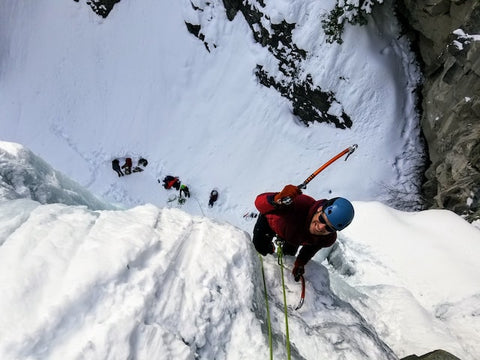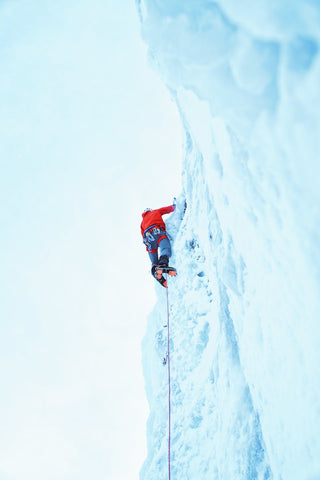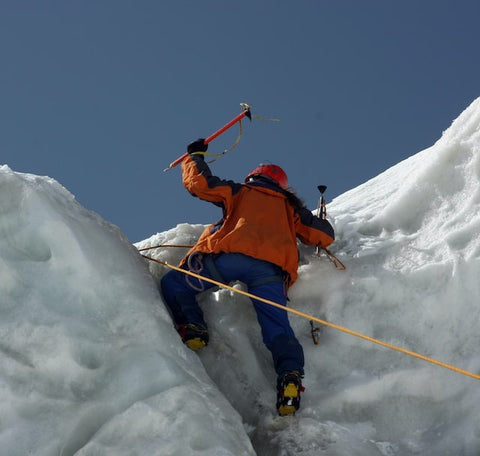You might be wondering if ice climbing is dangerous. Whether you’re a beginner or a seasoned pro, ice climbing is an incredibly dangerous sport.
Every year, people die while ice climbing and many more are seriously injured. While the statistics may be discouraging, there are ways to minimize the risk and have a safe, exciting, and fun time while ice climbing.
The Dangers of Ice Climbing
Ice climbing can be an incredibly dangerous sport if you're not careful. The biggest dangers come from falling ice or being hit by falling ice, but there are other risks for ice climbers as well. There are some of the dangers of ice climbing.
One of the most dangerous things about ice climbing is the risk of falling ice. If you're climbing near a cliff or in an area where there is loose ice, be aware that ice could break off and fall on you.
To avoid this, try to climb in areas where the ice is more solid, such as in a gully or couloir. Of course, the biggest danger when climbing is falling.
The Risks of Ice Climbing
Ice climbing is a dangerous sport. Every year, people die while ice climbing. The risks of ice climbing include falling, being hit by falling ice, and getting caught in an avalanche.
- Falling is the most common cause of death in ice climbing. Most falls occur when climbers lose their footing or their ice ax slips. Climbers can also fall if their rope breaks or if they are hit by falling ice.
- Being hit by falling ice is another major risk in ice climbing. Ice can break off from the cliff and fall on climbers below. This can happen when the ice is weak, when climbers are climbing above each other, or when the ice is melting.
- Avalanches are another major risk in ice climbing.
Is ice Climbing Safe?
No definitive answer exists to this question as opinions vary among experts; however, some generalizations can be made. Ice climbing is a potentially dangerous sport as it involves climbing up icy surfaces which can collapse suddenly and without warning. Furthermore, the use of ice axes and crampons can also present a hazard to both the climber and those around them. That being said, with the proper precautions in place, such as using the correct equipment and being aware of potential risks, ice climbing can be a safe and enjoyable activity.
Ice Climbing While Snowing?
If you love spending time outdoors and enjoy a challenge, then you should try ice climbing while it snows! It's an exhilarating experience that will leave you feeling accomplished. Plus, it's a great workout for your arms and legs.
Why is Ice Climbing Considered an Extreme Sport?
Ice climbing is considered an extreme sport for a number of reasons.
- Firstly, it is an activity that takes place in extremely cold conditions, which can be dangerous for the human body.
- Secondly, it requires a high level of fitness and technical skill to be able to scale an icy cliff face.
- Finally, ice climbing can be very dangerous, and even fatal, if the climber falls.

Minimizing the Risk of Climbing Ice
Many people ask me if ice climbing is dangerous. The answer, like with most things in life, is that there is a certain amount of risk inherent in the activity.
However, there are ways to minimize the risk and make ice climbing as safe as possible. First and foremost, it is important to have the proper equipment. This includes things like a good pair of ice axes, crampons, and a helmet. It is also important to know how to use this equipment properly.
If you are unsure, there are plenty of resources available to help you learn. Another important factor is choosing routes that are within your abilities.
How to Climb Safely?
Ice climbing can be a dangerous sport if you don't choose your routes carefully. There are many factors to consider when choosing an ice climbing route, such as the steepness of the slope, the thickness of the ice, and the presence of crevasses. The most important factor to consider when choosing an ice-climbing route is the steepness of the slope. A steep slope is more likely to collapse under your weight, and it's also more difficult to self-arrest if you fall. If you're not an experienced ice climber, it's best to avoid routes that are too steep.

Summary
A lot of people believe that ice climbing is a very dangerous sport. While it is true that there are some risks involved in ice climbing, as with any sport, there are also ways to minimize these risks. With proper training and equipment, ice climbing can be a safe and enjoyable activity. Keep in mind that ice climbing booths are important gear and make sure that you buy most comfortable ones.
Common Questions
Is ice climbing safer than rock climbing?
No definitive answer exists to the question of whether ice climbing is safer than rock climbing. However, there are a few key factors to consider that may impact the safety of each activity. First, rock climbing generally requires more upper-body strength than ice climbing. As a result, beginners may find ice climbing to be a more forgiving activity. Additionally, the tools used in ice climbing- such as ice axes and crampons- can provide a greater margin of safety than rock climbing gear. Finally, ice is a more predictable surface than rock, making it easier to plan routes and avoid hazards.
How difficult is ice climbing?
Ice climbing is one of the most difficult and dangerous sports in the world. It requires a high level of fitness, strength, endurance, and technical ice climbing skill. Most people who attempt it fail, and many who succeed are seriously injured or killed in the process.

Why is falling in ice climbing dangerous?
Falling is one of the most dangerous aspects of ice climbing. When a climber falls, they are often falling onto a hard surface, which can lead to serious injuries. Additionally, the ice can break and cause the climber to fall into a void below the surface. This can be especially dangerous if the void is filled with water.
Can you fall while ice climbing?
Yes, you can fall while ice climbing. The most common reason for falling is when your ice ax or crampon catches on the ice, causing you to lose your balance and fall. Other reasons for falling include slipping on the ice, hitting your head on the ice, and fatigue.
ABOUT THE AUTHOR
Fred Felton
Content Creator / Editor
Fred Felton is a copywriter, editor and social media specialist based in Durban, South Africa. He has over 20 years of experience in creating high end content. He has worked with some of the biggest brands in the world. Currently Fred specialises in the winter outdoors space, focussing on skiing and snowboarding. He is also a keynote speaker and has presented talks and workshops in South Africa.






